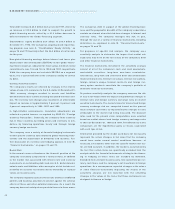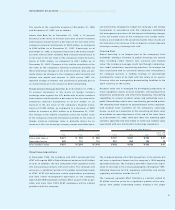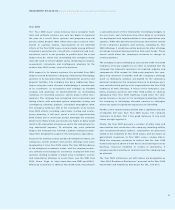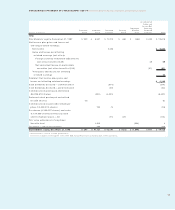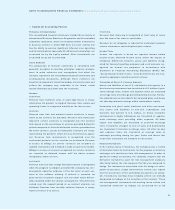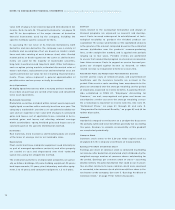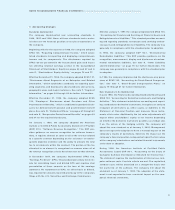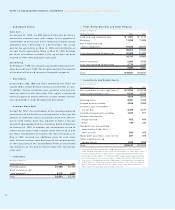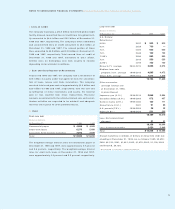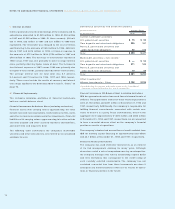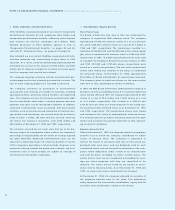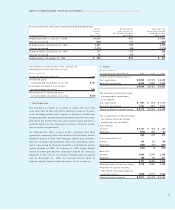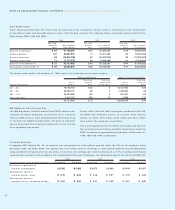IBM 1998 Annual Report Download - page 72
Download and view the complete annual report
Please find page 72 of the 1998 IBM annual report below. You can navigate through the pages in the report by either clicking on the pages listed below, or by using the keyword search tool below to find specific information within the annual report.
NOTES TO CONSOLIDATED FINANCIAL STATEMENTS International Business Machines Corporation and Subsidiary Companies
70
value with changes in fair value recognized immediately in net
income. Refer to note M, “Financial Instruments,” on pages 74
and 75 for descriptions of the major classes of derivative
financial instruments used by the company, including the
specific methods used to account for them.
In assessing the fair value of its financial instruments, both
derivative and non-derivative, the company uses a variety of
methods and assumptions that are based on market condi-
tions and risks existing at each balance sheet date. Quoted
market prices or dealer quotes for the same or similar instru-
ments are used for the majority of marketable securities,
long-term investments and long-term debt. Other techniques,
such as option pricing models, estimated discounted value of
future cash flows, replacement cost and termination cost, are
used to determine fair value for the remaining financial instru-
ments. These values represent a general approximation of
possible value and may never actually be realized.
Cash Equivalents
All highly liquid investments with a maturity of three months or
less at date of purchase are carried at fair value and considered
to be cash equivalents.
Marketable Securities
Marketable securities included within current assets represent
highly liquid securities with a maturity less than one year. The
company’s marketable securities are considered available for
sale and are reported at fair value with changes in unrealized
gains and losses, net of applicable taxes, recorded in Accu-
mulated gains and losses not affecting retained earnings
within stockholders’ equity. Realized gains and losses are cal-
culated based on the specific identification method.
Inventories
Raw materials, work in process and finished goods are stated
at the lower of average cost or net realizable value.
Depreciation
Plant, rental machines (computer equipment used internally or
as part of managed operations contracts) and other property
are carried at cost and depreciated over their estimated
useful lives using the straight-line method.
The estimated useful lives of depreciable properties are gener-
ally as follows: buildings, 50 years; building equipment, 20 years;
land improvements, 20 years; plant, laboratory and office equip-
ment, 2 to 15 years; and computer equipment, 1.5 to 5 years.
Software
Costs related to the conceptual formulation and design of
licensed programs are expensed as research and develop-
ment. Costs incurred subsequent to establishment of tech-
nological feasibility to produce the finished product are
capitalized. The annual amortization of the capitalized amounts
is the greater of the amount computed based on the estimated
revenue distribution over the products’ revenue-producing
lives, or the straight-line method, and is applied over periods
ranging up to four years. Periodic reviews are performed
to ensure that unamortized program costs remain recoverable
from future revenue. Costs to support or service licensed pro-
grams are charged against income as incurred, or when
related revenue is recognized, whichever occurs first.
Retirement Plans and Nonpension Postretirement Benefits
Current service costs of retirement plans and postretirement
healthcare and life insurance benefits are accrued in the
period. Prior service costs resulting from amendments to the
plans are amortized over the average remaining service period
of employees expected to receive benefits. Assuming thresh-
olds established in SFAS 87, “Employers’ Accounting for
Pensions,” are met, unrecognized net gains and losses are
amortized to service cost over the average remaining service
life of employees expected to receive benefits. See note W,
“Retirement Plans,” on page 81 through 83 and note X,
“Nonpension Postretirement Benefits,” on pages 83 and 84 for
further discussion.
Goodwill
Goodwill is charged to net income on a straight-line basis over
the periods estimated to be benefited, generally not exceeding
five years. Reviews to evaluate recoverability of this goodwill
are conducted periodically.
Common Stock
Common stock refers to the $.50 par value capital stock as
designated in the company’s Certificate of Incorporation.
Earnings Per Share of Common Stock
Earnings per share of common stock is computed by dividing
net income after deduction of preferred stock dividends by the
weighted-average number of common shares outstanding for
the period. Earnings per common share of stock—assuming
dilution reflects the potential dilution that could occur if securi-
ties or other contracts to issue common stock were exercised
or converted into common stock which would then share in the
net income of the company. See note T, “Earnings Per Share of
Common Stock,” on page 79 for further discussion.


